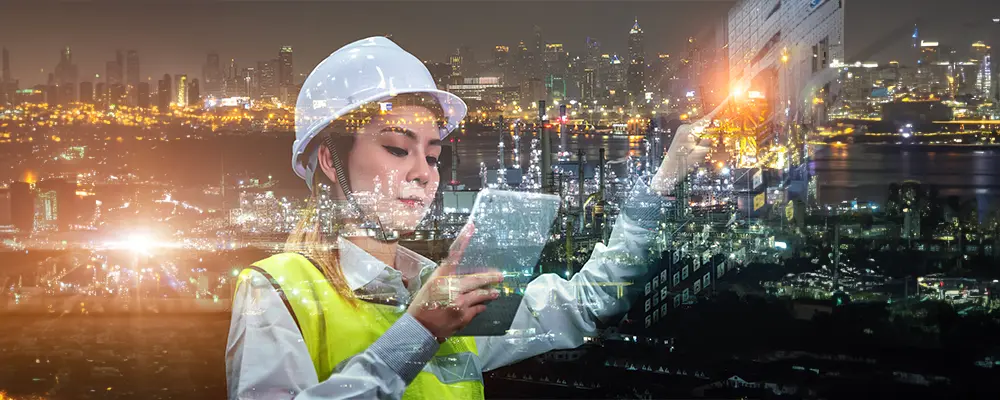Innovation is the cornerstone of progress in the exciting field of future construction technology. As the sector embraces digital change, we should expect a more connected, efficient, and sustainable built environment. Equipped with cutting-edge instruments and technology, construction experts will completely reimagine the possibilities of what can be constructed, how it can be constructed, and how it will affect the world.
After COVID, it has been shown that the popular perception that the construction sector is lagging in implementing modern technology in its daily operations is untrue. Despite overwhelming difficulties, the engineering and construction sectors emerged from the pandemic crisis better than others. Many are curious about the origins of this motivation. All of that was made possible by the ability to grow sustainably and the innovative application of technology in building.
The benefits and uses for updating your current processes are genuine and useful. To keep your construction company ahead of the competition, you’ll also need to figure out how to incorporate fresh ideas into your processes and strategy.
These state-of-the-art technologies are fundamentally altering future project completion and industry operations. In this Blog, Brick & Bolt will discuss the construction technologies that are impacting and changing the sector.
Construction Technology Types Affecting the Sector:
Significant advances in construction technology have affected many aspects of the industry. The following are a few categories of construction technologies that are impacting and changing the sector:
- Building Information Modeling (BIM) Software
- Data Collection Apps
- Drones
- Virtual Reality and Wearables
- Artificial Intelligence
- 3D Printing
- Blockchain Technology
- Digital Twin
- 3D Laser Scanner
- 4D Simulation
Building Information Modeling (BIM) Software:

Better teamwork is made possible by using BIM since individual contributors and areas of expertise can contribute to a single model rather than breaking out into separate copies of a 2D paper sketch. In this sense, as users input, the model changes instantly, simplifying the procedure and boosting productivity. By automating clash detection and supplying a more comprehensive view of the project, BIM also aids in problem solutions during a project’s design and planning phases.
An increasing number of governments worldwide, including those in India, Hong Kong, France, South Korea, Germany, and Italy, are implementing mandatory BIM processes for major facilities projects. Government construction projects in the United Kingdom are already required to use BIM. The growth of AI in BIM, the rise in demand for BIM-based cloud collaboration, modular construction and prefabrication, and more are rising trends that will directly affect the industry, according to Research and Market’s 2021 Building Information Modeling Market Report.
Data Collection Apps
Apps are becoming more commonplace in the construction industry, and for good cause. Improved communication and remote work are made possible by the improved portability of tablets and smartphones. More precisely, construction organisations are using data collecting tools to obtain data from the job site that is quicker, more precise, and of higher quality.
Although it takes less initial investment and is easier to integrate into existing processes, this kind of technology offers significant advantages such as:
- Significant time savings and a decrease in incorrect data entry: Users of data collection apps have claimed a 50% decrease in data input errors and a weekly savings of over 20 field and administrative hours.
- Improved procedures: Workflows for collecting data can be automated so that submitting one form starts another, and so on, until a task is finished with all required approvals and data collected. In addition, some data-gathering programs provide web and mobile forms, enabling your staff to complete forms on PCs, laptops, tablets, cellphones, and any other digital device.
- Increased adherence to safety regulations: Apps for gathering data can help with everything from reporting near-misses to doing thorough job safety analyses and daily equipment checks.
- Reporting immediately: A data-gathering tool will help you expedite reporting, whether you require daily job reports, prompt customer deliverable turnaround times, or quick access to legal documents. Additionally, you can quickly alter reports to meet your company’s requirements.
Drones
The most popular new technology in the building is drones. They are less expensive than aerial photography and can do site assessments faster and more precisely than a team on the ground. They may produce dynamic 3D or topographical maps and models, measure volumes, and take data from their high-resolution cameras.
Drones also have the advantage of safely inspecting areas that are difficult to access, including near big buildings or bridges. They can also monitor worker’s productivity and progress on a task site.
Virtual Reality and Wearables
BIM is frequently combined with virtual reality technology to help understand complex projects. Imagine the possibilities: using BIM to design a building, you can use virtual reality (VR) to walk around it. This will help your team or the client get a more accurate picture of the project’s appearance when it’s finished. Gaining a deeper understanding of the project before it starts allows you to steer clear of costly change orders and significant alterations in the middle of the project.
Artificial Intelligence

For many years, construction projects have benefited from artificial intelligence (AI) by being safer, having better workflows, and completing tasks more quickly and effectively. However, many construction companies still need to figure out how to use this sophisticated technology within their organisations.
Larger companies have begun developing AI systems to support internal operations and decision-making. On the other hand, others depend on outside parties, like AI advisors and solutions providers, to assess their present procedures and find areas where AI or machine learning may be used.
3D Printing
In the construction industry, 3D printing is one of the newest technologies. However, BIM is less popular than it is. It was originally applied in 1995 and involves creating three-dimensional buildings from computer models. In 2023, using 3D software to create 3D models is a popular trend.
Blockchain Technology
The AEC industry will have more effective cost control and blockchain-based procurement methods by 2023 and beyond. This technology, which functions as connected collections of data “blocks” that comprise a digital ledger with the records of all transactions and accomplished milestones, was first introduced to the construction sector less than ten years ago. It resembles a real chain, where each link signifies a different project transaction and self-corrects automatically. Unlike others, it is safe, decentralised, and flexible enough for projects of any scale.
Digital Twin
The digital twin, the newest AEC sector technology, solves operation management problems. Simulation is used to create a building prototype. Digital twin trends and functionality cover the application of intelligent multidimensional digital models. Because digital twins can mimic, forecast, and advise decisions based on real-world situations, there will be fewer buildings experiencing operational challenges in 2023 and beyond. Using patterns and spatial cues, digital twins analyse performance while considering occupant behaviour.
3D Laser Scanner
The 3D laser scanner is one of the newest tools for construction in the AEC sector. It is constantly an innovation because of its interoperability and annual changes. It is renowned for its capacity to examine and evaluate actual objects. It has been used for many construction jobs, including safety, project inspection, mapping, and on-site surveying. Because of its accuracy, building planning is simple and significantly less expensive.
4D Simulation
4D simulations are one of the newest technological options to save time and money for onsite and offsite projects, as the construction industry is always looking for ways to optimise processes.
Conclusion
The future of construction technology is undergoing dynamic and varied innovations in different sectors that transform the sector. To experience these technologies develop and are more extensively used, construction is expected to become more sustainable, efficient, and adaptable to society’s changing requirements.

